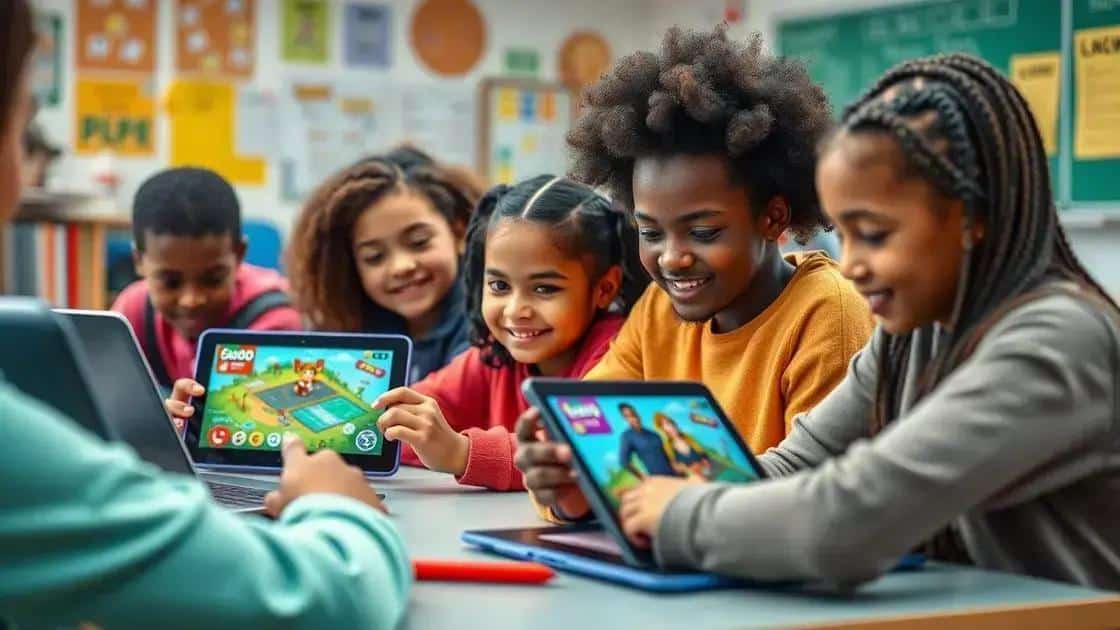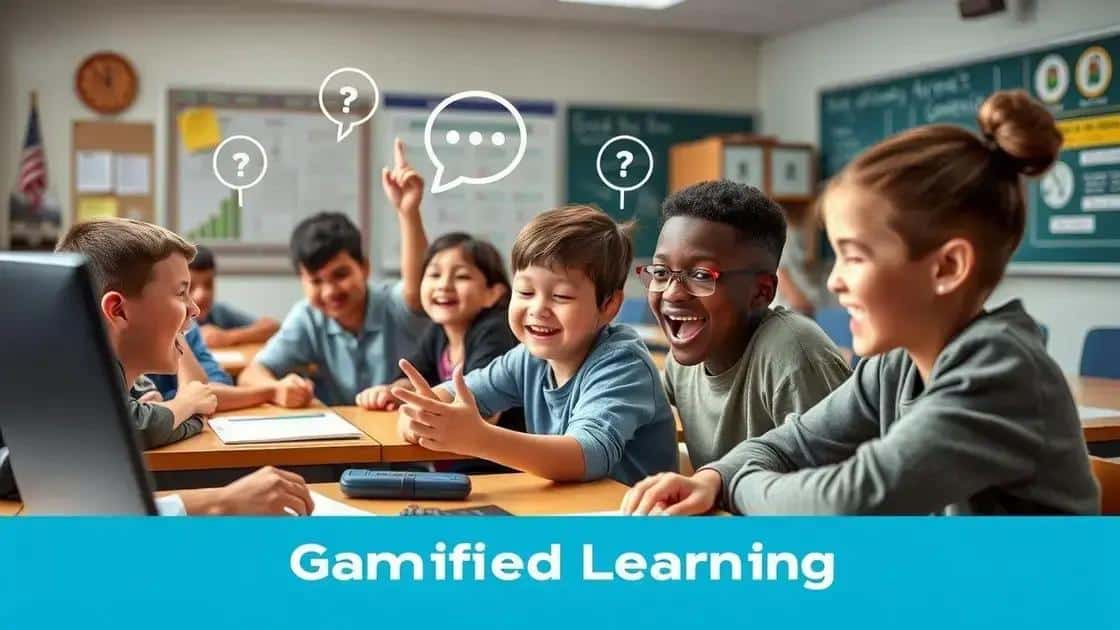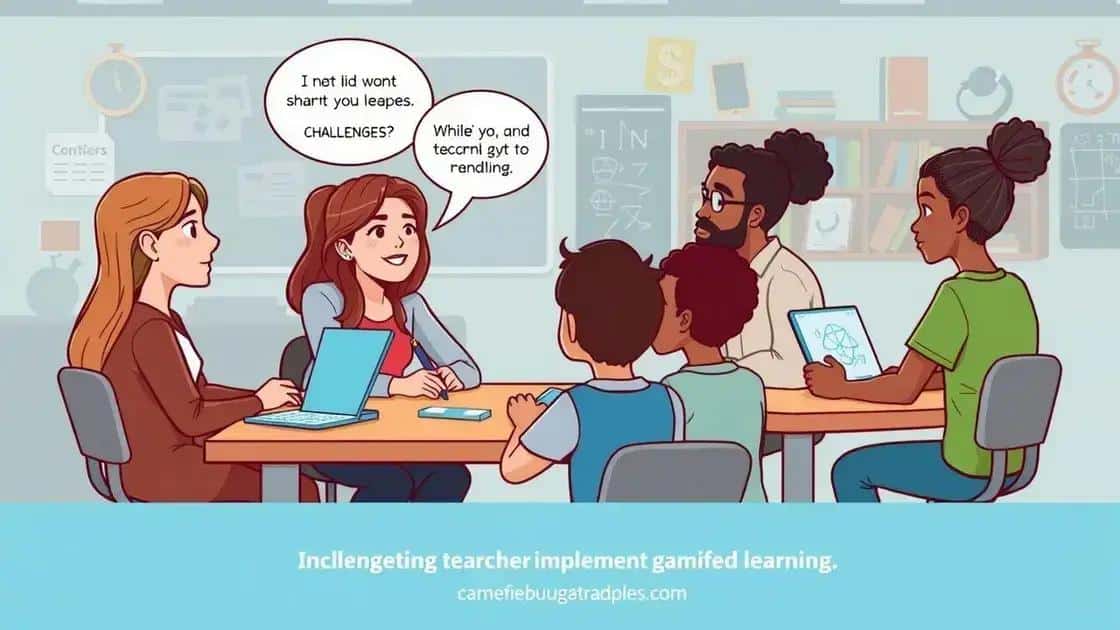Gamified learning platforms trends shaping education

Gamified learning platforms enhance student engagement and motivation by integrating game mechanics, but they face challenges like balancing fun with education, managing competitiveness, and ensuring equal access to technology.
Gamified learning platforms trends are changing how we engage with education. Have you ever thought about how these innovative strategies can make learning more enjoyable? Let’s dive into this exciting topic!
Understanding gamified learning platforms
Understanding gamified learning platforms is essential in today’s educational landscape. These platforms use game elements to engage learners and enhance their experiences. When effectively designed, they can transform the way students absorb information and develop skills.
What Are Gamified Learning Platforms?
Gamified learning platforms incorporate game mechanics in educational environments. This means adding elements like points, badges, and leaderboards to motivate students. By leveraging competition and reward systems, these platforms can boost engagement and learning outcomes.
Benefits of Gamification in Learning
Using gamification in education has several advantages. Here are a few key benefits:
- Increased engagement: Students are more likely to participate in learning activities when they are game-like.
- Enhanced retention: Gamification can improve memory retention by making information more memorable.
- Motivation Boost: Reward systems encourage students to strive for higher achievements.
Moreover, gamified learning platforms can foster a sense of community among learners. When students interact in a game-like environment, they often collaborate and support one another. This collaborative spirit can make learning more enjoyable and effective.
As educators begin to understand these platforms better, the potential for innovation in teaching methods expands. They can create personalized learning journeys that adapt to individual needs, making the learning experience even more impactful.
Challenges of Gamified Learning Platforms
While these platforms offer many benefits, there are challenges to consider. It’s crucial to design gamified experiences that are educational and not just entertaining. Balancing fun and learning can be tricky, and educators need to ensure that game elements do not distract from learning objectives. Additionally, some students may feel pressure from competition, which could lead to anxiety. Understanding these challenges helps educators better leverage the strengths of gamified platforms.
Overall, the push towards gamified education is a response to the changing needs of learners. As we embrace technology in classrooms, gamified learning platforms emerge as a promising solution to engage students and enhance their educational journeys.
Key benefits of gamified learning

Gamified learning offers several key benefits that can significantly enhance the educational experience. By incorporating game elements into learning, students often become more engaged and motivated to participate in their education.
Boosting Student Engagement
One of the primary advantages of gamified learning is its ability to boost student engagement. When educational content is presented in a game-like format, learners are more likely to interact with the material. This interactive approach transforms lessons into captivating experiences that maintain interest.
Fostering Motivation
Another key benefit is the increased motivation among students. Gamification introduces challenges and rewards that encourage learners to strive for success. This motivation can lead to a higher completion rate of assignments and a deeper understanding of the subject matter.
- Immediate feedback: Gamified platforms often provide instant feedback, allowing students to track their progress.
- Reward systems: Badges and points create a motivating environment, pushing students to improve.
- Personalized learning: Gamified experiences often adapt to individual learning styles, making education more effective.
Furthermore, the collaborative elements of gamified learning can enhance social interactions among students. When learners work together to achieve goals, they develop important teamwork skills. This collaboration can also create a supportive atmosphere where students feel comfortable sharing ideas and helping each other.
Enhancing Retention of Knowledge
Gamified learning platforms can lead to improved retention of knowledge as well. The combination of fun and educational content makes topics more memorable. Students will find it easier to recall information when it is tied to a positive experience. This transformation can create a lasting impact on their learning journey.
As educators continue to explore and implement these platforms, they find creative ways to combine fun and education. By recognizing the key benefits of gamified learning, schools can adopt more innovative approaches to engage students effectively in their educational pursuits.
Emerging trends in gamification
Emerging trends in gamification reflect the evolving landscape of education and technology. As more educational institutions adopt these strategies, it’s important to recognize how they are shaping the learning environment. These trends harness the motivational aspects of games to create engaging learning experiences.
Integration of Virtual Reality
One exciting trend is the integration of virtual reality (VR) in gamified learning. VR allows students to immerse themselves in a 3D environment, making complex subjects more accessible. This technology creates interactive experiences that can enhance understanding and retention of information.
Use of Artificial Intelligence
Another notable trend is the use of artificial intelligence (AI) to personalize learning experiences. AI can analyze a student’s performance and adapt challenges to suit individual learning paces. This personalization not only helps in maintaining engagement but also ensures that students receive the support they need.
- Adaptive learning systems: These systems adjust content and difficulty in real-time based on student performance.
- AI-driven feedback: Instant feedback from AI systems helps students identify areas for improvement.
- Customized learning paths: AI can create tailored paths for students, aligning with their unique needs and preferences.
Furthermore, mobile gamification is becoming increasingly popular. With the rise of smartphones, learning can take place anywhere. Students can access gamified platforms on their devices, making it easier to stay engaged outside the classroom. This trend is particularly beneficial as it promotes learning flexibility and accessibility.
Focus on Social Interaction
Social interaction is another key trend in gamification. Platforms are now incorporating social features that encourage collaboration among peers. Features like leaderboards, team challenges, and multiplayer settings foster a sense of community and healthy competition, which can enhance motivation.
As institutions continue to explore these emerging trends, the future of gamified learning looks promising. By adapting to new technologies and cultural shifts, educators are finding innovative ways to engage students and support their learning journeys.
Challenges in implementing gamified learning

Challenges in implementing gamified learning are important to consider as educational institutions embrace these innovative strategies. While gamification brings many benefits, it also poses unique difficulties that educators must navigate.
Balancing Fun and Education
One significant challenge is finding the right balance between fun and education. If the gamified elements are too focused on entertainment, they might overshadow the learning objectives. Educators must ensure that game mechanics support educational goals and do not detract from the learning experience.
Student Anxiety and Competition
Another challenge is the potential for increased anxiety among students due to competition. While some students thrive in competitive environments, others may feel overwhelmed. This can lead to stress and disengagement, which is counterproductive to the goals of gamified learning.
- Understanding individual differences: Educators should recognize that students respond differently to competition.
- Creating supportive environments: Schools can implement strategies to reduce pressure and promote teamwork.
- Offering choice: Allowing students to choose their level of engagement in gamified activities can help alleviate anxiety.
Moreover, access to technology can be a barrier to effective implementation. Not all students may have equal access to devices or reliable internet. This digital divide can lead to inequities in learning opportunities, making it essential for schools to address these access issues.
Staff Training and Development
Furthermore, inadequate training for educators is a significant hurdle. Teachers may not be familiar with gamification techniques or how to integrate them into their curricula. Providing adequate training can empower educators to implement gamified strategies effectively. Without this support, the potential of gamification may not be fully realized.
As schools face these challenges, open communication and collaboration among educators can foster more successful implementations. By identifying and addressing obstacles collaboratively, schools can create more engaging and effective learning environments through gamification.
In conclusion, gamified learning offers a dynamic way to engage students and make education more enjoyable. By incorporating game mechanics, schools can boost motivation and enhance the learning experience. However, educators must be aware of the challenges that come with implementing gamification effectively. Balancing fun with educational objectives, addressing student anxiety, and ensuring equitable access to technology are crucial considerations. With proper training and collaborative efforts, educators can successfully navigate these challenges and create a more engaging and effective learning environment for all students.
FAQ – Frequently Asked Questions about Gamified Learning
What is gamified learning?
Gamified learning incorporates game elements like points and badges into educational activities to engage students and enhance learning experiences.
How does gamification improve student motivation?
Gamification increases student motivation by adding fun challenges and rewards that encourage learners to participate and succeed in their educational journeys.
What are some challenges of implementing gamified learning?
Challenges include balancing entertainment with educational goals, managing student anxiety due to competition, and ensuring equitable access to technology.
How can schools properly train educators in gamification?
Schools can provide professional development sessions and workshops to familiarize educators with gamification techniques and how to integrate them effectively in their teaching.






